3.E: Cost-Volume-Profit Analysis (Exercises)
- Page ID
- 11853
\( \newcommand{\vecs}[1]{\overset { \scriptstyle \rightharpoonup} {\mathbf{#1}} } \)
\( \newcommand{\vecd}[1]{\overset{-\!-\!\rightharpoonup}{\vphantom{a}\smash {#1}}} \)
\( \newcommand{\dsum}{\displaystyle\sum\limits} \)
\( \newcommand{\dint}{\displaystyle\int\limits} \)
\( \newcommand{\dlim}{\displaystyle\lim\limits} \)
\( \newcommand{\id}{\mathrm{id}}\) \( \newcommand{\Span}{\mathrm{span}}\)
( \newcommand{\kernel}{\mathrm{null}\,}\) \( \newcommand{\range}{\mathrm{range}\,}\)
\( \newcommand{\RealPart}{\mathrm{Re}}\) \( \newcommand{\ImaginaryPart}{\mathrm{Im}}\)
\( \newcommand{\Argument}{\mathrm{Arg}}\) \( \newcommand{\norm}[1]{\| #1 \|}\)
\( \newcommand{\inner}[2]{\langle #1, #2 \rangle}\)
\( \newcommand{\Span}{\mathrm{span}}\)
\( \newcommand{\id}{\mathrm{id}}\)
\( \newcommand{\Span}{\mathrm{span}}\)
\( \newcommand{\kernel}{\mathrm{null}\,}\)
\( \newcommand{\range}{\mathrm{range}\,}\)
\( \newcommand{\RealPart}{\mathrm{Re}}\)
\( \newcommand{\ImaginaryPart}{\mathrm{Im}}\)
\( \newcommand{\Argument}{\mathrm{Arg}}\)
\( \newcommand{\norm}[1]{\| #1 \|}\)
\( \newcommand{\inner}[2]{\langle #1, #2 \rangle}\)
\( \newcommand{\Span}{\mathrm{span}}\) \( \newcommand{\AA}{\unicode[.8,0]{x212B}}\)
\( \newcommand{\vectorA}[1]{\vec{#1}} % arrow\)
\( \newcommand{\vectorAt}[1]{\vec{\text{#1}}} % arrow\)
\( \newcommand{\vectorB}[1]{\overset { \scriptstyle \rightharpoonup} {\mathbf{#1}} } \)
\( \newcommand{\vectorC}[1]{\textbf{#1}} \)
\( \newcommand{\vectorD}[1]{\overrightarrow{#1}} \)
\( \newcommand{\vectorDt}[1]{\overrightarrow{\text{#1}}} \)
\( \newcommand{\vectE}[1]{\overset{-\!-\!\rightharpoonup}{\vphantom{a}\smash{\mathbf {#1}}}} \)
\( \newcommand{\vecs}[1]{\overset { \scriptstyle \rightharpoonup} {\mathbf{#1}} } \)
\( \newcommand{\vecd}[1]{\overset{-\!-\!\rightharpoonup}{\vphantom{a}\smash {#1}}} \)
\(\newcommand{\avec}{\mathbf a}\) \(\newcommand{\bvec}{\mathbf b}\) \(\newcommand{\cvec}{\mathbf c}\) \(\newcommand{\dvec}{\mathbf d}\) \(\newcommand{\dtil}{\widetilde{\mathbf d}}\) \(\newcommand{\evec}{\mathbf e}\) \(\newcommand{\fvec}{\mathbf f}\) \(\newcommand{\nvec}{\mathbf n}\) \(\newcommand{\pvec}{\mathbf p}\) \(\newcommand{\qvec}{\mathbf q}\) \(\newcommand{\svec}{\mathbf s}\) \(\newcommand{\tvec}{\mathbf t}\) \(\newcommand{\uvec}{\mathbf u}\) \(\newcommand{\vvec}{\mathbf v}\) \(\newcommand{\wvec}{\mathbf w}\) \(\newcommand{\xvec}{\mathbf x}\) \(\newcommand{\yvec}{\mathbf y}\) \(\newcommand{\zvec}{\mathbf z}\) \(\newcommand{\rvec}{\mathbf r}\) \(\newcommand{\mvec}{\mathbf m}\) \(\newcommand{\zerovec}{\mathbf 0}\) \(\newcommand{\onevec}{\mathbf 1}\) \(\newcommand{\real}{\mathbb R}\) \(\newcommand{\twovec}[2]{\left[\begin{array}{r}#1 \\ #2 \end{array}\right]}\) \(\newcommand{\ctwovec}[2]{\left[\begin{array}{c}#1 \\ #2 \end{array}\right]}\) \(\newcommand{\threevec}[3]{\left[\begin{array}{r}#1 \\ #2 \\ #3 \end{array}\right]}\) \(\newcommand{\cthreevec}[3]{\left[\begin{array}{c}#1 \\ #2 \\ #3 \end{array}\right]}\) \(\newcommand{\fourvec}[4]{\left[\begin{array}{r}#1 \\ #2 \\ #3 \\ #4 \end{array}\right]}\) \(\newcommand{\cfourvec}[4]{\left[\begin{array}{c}#1 \\ #2 \\ #3 \\ #4 \end{array}\right]}\) \(\newcommand{\fivevec}[5]{\left[\begin{array}{r}#1 \\ #2 \\ #3 \\ #4 \\ #5 \\ \end{array}\right]}\) \(\newcommand{\cfivevec}[5]{\left[\begin{array}{c}#1 \\ #2 \\ #3 \\ #4 \\ #5 \\ \end{array}\right]}\) \(\newcommand{\mattwo}[4]{\left[\begin{array}{rr}#1 \amp #2 \\ #3 \amp #4 \\ \end{array}\right]}\) \(\newcommand{\laspan}[1]{\text{Span}\{#1\}}\) \(\newcommand{\bcal}{\cal B}\) \(\newcommand{\ccal}{\cal C}\) \(\newcommand{\scal}{\cal S}\) \(\newcommand{\wcal}{\cal W}\) \(\newcommand{\ecal}{\cal E}\) \(\newcommand{\coords}[2]{\left\{#1\right\}_{#2}}\) \(\newcommand{\gray}[1]{\color{gray}{#1}}\) \(\newcommand{\lgray}[1]{\color{lightgray}{#1}}\) \(\newcommand{\rank}{\operatorname{rank}}\) \(\newcommand{\row}{\text{Row}}\) \(\newcommand{\col}{\text{Col}}\) \(\renewcommand{\row}{\text{Row}}\) \(\newcommand{\nul}{\text{Nul}}\) \(\newcommand{\var}{\text{Var}}\) \(\newcommand{\corr}{\text{corr}}\) \(\newcommand{\len}[1]{\left|#1\right|}\) \(\newcommand{\bbar}{\overline{\bvec}}\) \(\newcommand{\bhat}{\widehat{\bvec}}\) \(\newcommand{\bperp}{\bvec^\perp}\) \(\newcommand{\xhat}{\widehat{\xvec}}\) \(\newcommand{\vhat}{\widehat{\vvec}}\) \(\newcommand{\uhat}{\widehat{\uvec}}\) \(\newcommand{\what}{\widehat{\wvec}}\) \(\newcommand{\Sighat}{\widehat{\Sigma}}\) \(\newcommand{\lt}{<}\) \(\newcommand{\gt}{>}\) \(\newcommand{\amp}{&}\) \(\definecolor{fillinmathshade}{gray}{0.9}\)Multiple Choice
- The amount of a unit’s sales price that helps to cover fixed expenses is its ________.
- contribution margin
- profit
- variable cost
- stepped cost
- Answer:
-
a
- A company’s product sells for \(\$150\) and has variable costs of \(\$60\) associated with the product. What is its contribution margin per unit?
- \(\$40\)
- \(\$60\)
- \(\$90\)
- \(\$150\)
- A company’s product sells for \(\$150\) and has variable costs of \(\$60\) associated with the product. What is its contribution margin ratio?
- \(10\%\)
- \(40\%\)
- \(60\%\)
- \(90\%\)
- Answer:
-
c
- A company’s contribution margin per unit is \(\$25\). If the company increases its activity level from \(200\) units to \(350\) units, how much will its total contribution margin increase?
- \(\$1,250\)
- \(\$3,750\)
- \(\$5,000\)
- \(\$8,750\)
- A company sells its products for \(\$80\) per unit and has per-unit variable costs of \(\$30\). What is the contribution margin per unit?
- \(\$30\)
- \(\$50\)
- \(\$80\)
- \(\$110\)
- Answer:
-
b
- If a company has fixed costs of \(\$6,000\) per month and their product that sells for \(\$200\) has a contribution margin ratio of \(30\%\), how many units must they sell in order to break even?
- \(100\)
- \(180\)
- \(200\)
- \(2,000\)
- Company A wants to earn \(\$5,000\) profit in the month of January. If their fixed costs are \(\$10,000\) and their product has a per-unit contribution margin of \(\$250\), how many units must they sell to reach their target income?
- \(20\)
- \(40\)
- \(60\)
- \(120\)
- Answer:
-
c
- A company wants to earn an income of \(\$60,000\) after-taxes. If the tax rate is \(32\%\), what must be the company’s pre-tax income in order to have \(\$60,000\) after-taxes?
- \(\$88,235\)
- \(\$19,200\)
- \(\$79,200\)
- \(\$143,000\)
- A company has pre-tax or operating income of \(\$120,000\). If the tax rate is \(40\%\), what is the company’s after-tax income?
- \(\$300,000\)
- \(\$240,000\)
- \(\$48,000\)
- \(\$72,000\)
- Answer:
-
d
- When sales price increases and all other variables are held constant, the break-even point will ________.
- remain unchanged
- increase
- decrease
- produce a lower contribution margin
- When sales price decreases and all other variables are held constant, the break-even point will ________.
- remain unchanged
- increase
- decrease
- produce a higher contribution margin
- Answer:
-
b
- When variable costs increase and all other variables remain unchanged, the break-even point will ________.
- remain unchanged
- increase
- decrease
- produce a lower contribution margin
- When fixed costs decrease and all other variables remain unchanged, the break-even point will ________.
- remain unchanged
- increase
- decrease
- produce a lower contribution margin
- Answer:
-
c
- When fixed costs increase and all other variables remain unchanged, the contribution margin will ________.
- remain unchanged
- increase
- decrease
- increase variable costs per unit
- If the sales mix in a multi-product environment shifts to a higher volume in low contribution margin products, the break-even point will ________.
- remain unchanged because all products are included in the calculation of break-even
- increase because the low contribution margin products have little effect on break-even
- increase because the per composite unit contribution margin will decrease
- decrease because the per composite unit contribution margin will increase
- Answer:
-
c
- Break-even for a multiple product firm ________.
- can be calculated by dividing total fixed costs by the contribution margin of a composite unit
- can be calculated by multiplying fixed costs by the contribution margin ratio of a composite unit
- can only be calculated when the proportion of products sold is the same for all products
- can be calculated by multiplying fixed costs by the contribution margin ratio of the most common product in the sales mix
- Waskowski Company sells three products (A, B, and C) with a sales mix of \(3:2:1\). Unit sales price are shown. What is the sales price per composite unit?

- \(\$17.00\)
- \(\$25.00\)
- \(\$35.00\)
- \(\$20.00\)
- Answer:
-
c
- Beaucheau Farms sells three products (E, F, and G) with a sale mix ratio of \(3:1:2\). Unit sales price are shown. What is the sales price per composite unit?

- \(\$28.00\)
- \(\$20.00\)
- \(\$59.00\)
- \(\$41.00\)
- A company sells two products, Model 101 and Model 202. For every one unit of Model 101, they sell they sell two units of Model 202. Sales and cost information for the two products is shown. What is the contribution margin for a composite unit based on the sales mix?
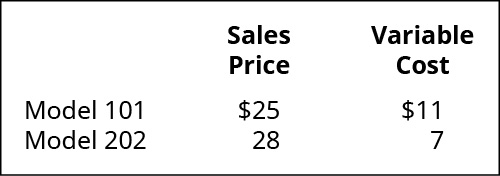
- $14
- $21
- $35
- $56
- Answer:
-
d
- Wallace Industries has total contribution margin of \(\$58,560\) and net income of \(\$24,400\) for the month of April. Wallace expects sales volume to increase by \(5\%\) in May. What are the degree of operating leverage and the expected percent change in income for Wallace Industries?
- \(0.42\) and \(2.2\%\)
- \(0.42\) and \(5\%\)
- \(2.4\) and \(12\%\)
- \(2.5\) and \(13\%\)
- Macom Manufacturing has total contribution margin of \(\$61,250\) and net income of \(\$24,500\) for the month of June. Marcus expects sales volume to increase by \(10\%\) in July. What are the degree of operating leverage and the expected percent change in income for Macom Manufacturing?
- \(0.4\) and \(10\%\)
- \(2.5\) and \(10\%\)
- \(2.5\) and \(25\%\)
- \(5.0\) and \(50\%\)
- Answer:
-
c
- If a firm has a contribution margin of \(\$59,690\) and a net income of \(\$12,700\) for the current month, what is their degree of operating leverage?
- \(0.18\)
- \(1.18\)
- \(2.4\)
- \(4.7\)
- If a firm has a contribution margin of \(\$78,090\) and a net income of \(\$13,700\) for the current month, what is their degree of operating leverage?
- \(0.21\)
- \(1.21\)
- \(2.4\)
- \(5.7\)
- Answer:
-
d
Questions
- Define and explain contribution margin on a per unit basis.
- Answer:
-
Answers will vary. Responses should include that per-unit contribution margin is the amount by which a product’s selling price exceeds it total variable cost per unit.
- Define and explain contribution margin ratio.
- Explain how a contribution margin income statement can be used to determine profitability.
- Answer:
-
Answers will vary. Responses should include that contribution income statements express total contribution margin for a given level of activity and can be useful in making decisions about product pricing and optimal levels of activity.
- In a cost-volume-profit analysis, explain what happens at the break-even point and why companies do not want to remain at the break-even point.What is meant by a product’s contribution margin ratio and how is this ratio useful in planning business operations?
- Explain how a manager can use CVP analysis to make decisions regarding changes in operations or pricing structure.
- Answer:
-
Answers will vary. Responses should include the fact that the contribution margin ratio represents the percentage of every sales dollar available to cover fixed expenses. Businesses can use this ratio when projecting profit at various levels of sales revenue.
- After conducting a CVP analysis, most businesses will then recreate a revised or projected income statement incorporating the results of the CVP analysis. What is the benefit of taking this extra step in the analysis?
- Explain how it is possible for costs to change without changing the break-even point.
- Answer:
-
Answers will vary. Responses should include a description of how the CVP analysis information can be brought into a projected income statement that takes into account additional revenues and expenses of the business to create a “big picture” of what happens as a result of a change in cost, volume, and profit.
- Explain what a sales mix is and how changes in the sales mix affect the break-even point.
- Explain how break-even analysis for a multi-product company differs from a company selling a single product.
- Answer:
-
Answers will vary. Responses should include the definition of sales mix as the relative proportions in which a company’s products are sold as well as a description of how products within the sales mix have unique sales prices, variable costs, and contribution margins.
- Explain margin of safety and why it is an important measurement for managers.
- Define operating leverage and explain its importance to a company and how it relates to risk.
- Answer:
-
Answers will vary. Responses should include an explanation of how margin of safety allows the business to operate at a level where the risk of falling to or below the break-even point is low. There should also be some mention of the usefulness of the margin safety as an “alarm” for companies, such that when sales fall to the margin of safety level, action may be warranted.
Exercise Set A
- Calculate the per-unit contribution margin of a product that has a sale price of \(\$200\) if the variable costs per unit are \(\$65\).
- Calculate the per-unit contribution margin of a product that has a sale price of \(\$400\) if the variable costs per unit are \(\$165\).
- A product has a sales price of \(\$150\) and a per-unit contribution margin of \(\$50\). What is the contribution margin ratio?
- A product has a sales price of \(\$250\) and a per-unit contribution margin of \(\$75\). What is the contribution margin ratio?
- Maple Enterprises sells a single product with a selling price of \(\$75\) and variable costs per unit of \(\$30\). The company’s monthly fixed expenses are \(\$22,500\).
- What is the company’s break-even point in units?
- What is the company’s break-even point in dollars?
- Construct a contribution margin income statement for the month of September when they will sell \(900\) units.
- How many units will Maple need to sell in order to reach a target profit of \(\$45,000\)?
- What dollar sales will Maple need in order to reach a target profit of \(\$45,000\)?
- Construct a contribution margin income statement for Maple that reflects \(\$150,000\) in sales volume.
- Marlin Motors sells a single product with a selling price of \(\$400\) with variable costs per unit of \(\$160\). The company’s monthly fixed expenses are \(\$36,000\).
- What is the company’s break-even point in units?
- What is the company’s break-even point in dollars?
- Prepare a contribution margin income statement for the month of November when they will sell \(130\) units.
- How many units will Marlin need to sell in order to realize a target profit of \(\$48,000\)?
- What dollar sales will Marlin need to generate in order to realize a target profit of \(\$48,000\)?
- Construct a contribution margin income statement for the month of February that reflects \(\$200,000\) in sales revenue for Marlin Motors.
- Flanders Manufacturing is considering purchasing a new machine that will reduce variable costs per part produced by \(\$0.15\). The machine will increase fixed costs by \(\$18,250\) per year. The information they will use to consider these changes is shown here.
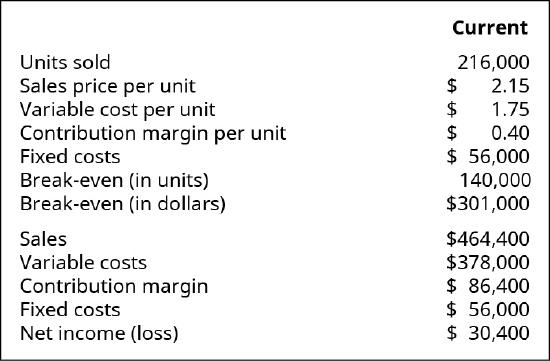
- Marchete Company produces a single product. They have recently received the results of a market survey that indicates that they can increase the retail price of their product by \(8\%\) without losing customers or market share. All other costs will remain unchanged. Their most recent CVP analysis is shown. If they enact the \(8\%\) price increase, what will be their new break-even point in units and dollars?

- Brahma Industries sells vinyl replacement windows to home improvement retailers nationwide. The national sales manager believes that if they invest an additional \(\$25,000\) in advertising, they would increase sales volume by \(10,000\) units. Prepare a forecasted contribution margin income statement for Brahma if they incur the additional advertising costs, using this information:

- Salvador Manufacturing builds and sells snowboards, skis and poles. The sales price and variable cost for each are shown:

Their sales mix is reflected in the ratio \(7:3:2\). What is the overall unit contribution margin for Salvador with their current product mix?
- Salvador Manufacturing builds and sells snowboards, skis and poles. The sales price and variable cost for each follows:

Their sales mix is reflected in the ratio \(7:3:2\). If annual fixed costs shared by the three products are \(\$196,200\), how many units of each product will need to be sold in order for Salvador to break even?
- Use the information from the previous exercises involving Salvador Manufacturing to determine their break-even point in sales dollars.
- Company A has current sales of \(\$10,000,000\) and a \(45\%\) contribution margin. Its fixed costs are \(\$3,000,000\). Company B is a service firm with current service revenue of \(\$5,000,000\) and a \(20\%\) contribution margin. Company B’s fixed costs are \(\$500,000\). Compute the degree of operating leverage for both companies. Which company will benefit most from a \(25\%\) increase in sales? Explain why.
- Marshall & Company produces a single product and recently calculated their break-even point as shown.

What would Marshall’s target margin of safety be in units and dollars if they required a \(\$14,000\) margin of safety?
Exercise Set B
- Calculate the per-unit contribution margin of a product that has a sale price of \(\$150\) if the variable costs per unit are \(\$40\).
- Calculate the per-unit contribution margin of a product that has a sale price of \(\$350\) if the variable costs per unit are \(\$95\).
- A product has a sales price of \(\$175\) and a per-unit contribution margin of \(\$75\). What is the contribution margin ratio?
- A product has a sales price of \(\$90\) and a per-unit contribution margin of \(\$30\). What is the contribution margin ratio?
- Cadre, Inc., sells a single product with a selling price of \(\$120\) and variable costs per unit of \(\$90\). The company’s monthly fixed expenses are \(\$180,000\).
- What is the company’s break-even point in units?
- What is the company’s break-even point in dollars?
- Prepare a contribution margin income statement for the month of October when they will sell \(10,000\) units.
- How many units will Cadre need to sell in order to realize a target profit of \(\$300,000\)?
- What dollar sales will Cadre need to generate in order to realize a target profit of \(\$300,000\)?
- Construct a contribution margin income statement for the month of August that reflects \(\$2,400,000\) in sales revenue for Cadre, Inc.
- Kerr Manufacturing sells a single product with a selling price of \(\$600\) with variable costs per unit of \(\$360\). The company’s monthly fixed expenses are \(\$72,000\).
- What is the company’s break-even point in units?
- What is the company’s break-even point in dollars?
- Prepare a contribution margin income statement for the month of January when they will sell \(500\) units.
- How many units will Kerr need to sell in order to realize a target profit of \(\$120,000\)?
- What dollar sales will Kerr need to generate in order to realize a target profit of \(\$120,000\)?
- Construct a contribution margin income statement for the month of June that reflects \(\$600,000\) in sales revenue for Kerr Manufacturing.
- Delta Co. sells a product for \(\$150\) per unit. The variable cost per unit is \(\$90\) and fixed costs are \(\$15,250\). Delta Co.’s tax rate is \(36\%\) and the company wants to earn \(\$44,000\) after taxes.
- What would be Delta’s desired pre-tax income?
- What would be break-even point in units to reach the income goal of \(\$44,000\) after taxes?
- What would be break-even point in sales dollars to reach the income goal of \(\$44,000\) after taxes?
- Create a contribution margin income statement to show that the break-even point calculated in B, generates the desired after-tax income.
- Shonda & Shonda is a company that does land surveys and engineering consulting. They have an opportunity to purchase new computer equipment that will allow them to render their drawings and surveys much more quickly. The new equipment will cost them an additional \(\$1,200\) per month, but they will be able to increase their sales by \(10\%\) per year. Their current annual cost and break-even figures are as follows:
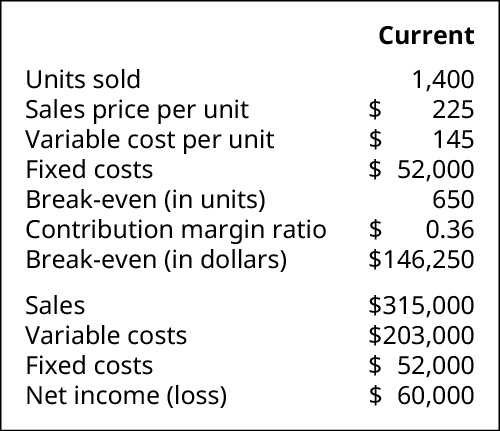
- What will be the impact on the break-even point if Shonda & Shonda purchases the new computer?
- What will be the impact on net operating income if Shonda & Shonda purchases the new computer?
- What would be your recommendation to Shonda & Shonda regarding this purchase?
- Baghdad Company produces a single product. They have recently received the result of a market survey that indicates that they can increase the retail price of their product by \(10\%\) without losing customers or market share. All other costs will remain unchanged. If they enact the \(10\%\) price increase, what will be their new break-even point in units and dollars? Their most recent CVP analysis is:
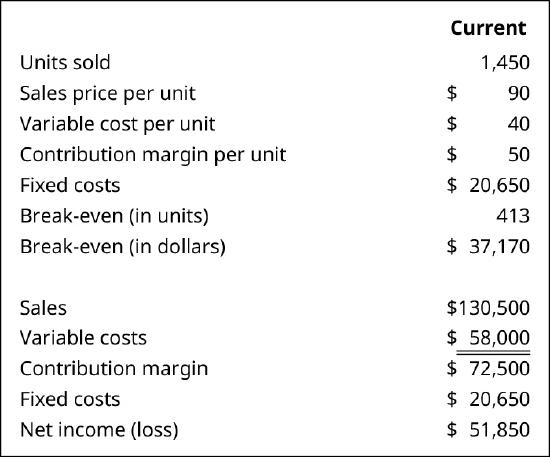
- Keleher Industries manufactures pet doors and sells them directly to the consumer via their web site. The marketing manager believes that if the company invests in new software, they will increase their sales by \(10\%\). The new software will increase fixed costs by \(\$400\) per month. Prepare a forecasted contribution margin income statement for Keleher Industries reflecting the new software cost and associated increase in sales. The previous annual statement is as follows:

- JJ Manufacturing builds and sells switch harnesses for glove boxes. The sales price and variable cost for each follows:

Their sales mix is reflected in the ratio \(4:4:1\). What is the overall unit contribution margin for JJ Manufacturing with their current product mix?
- JJ Manufacturing builds and sells switch harnesses for glove boxes. The sales price and variable cost for each follow:

Their sales mix is reflected in the ratio \(4:4:1\). If annual fixed costs shared by the three products are \(\$18,840\) how many units of each product will need to be sold in order for JJ to break even?
- Use the information from the previous exercises involving JJ Manufacturing to determine their break-even point in sales dollars.
- Company A has current sales of \(\$4,000,000\) and a \(45\%\) contribution margin. Its fixed costs are \(\$600,000\). Company B is a service firm with current service revenue of \(\$2,800,000\) and a \(15\%\) contribution margin. Company B’s fixed costs are \(\$375,000\). Compute the degree of operating leverage for both companies. Which company will benefit most from a \(15\%\) increase in sales? Explain why.
- Best Wholesale recently calculated their break-even point for their Midwest operations. The national sales manager has asked them to include a \(\$10,500\) margin of safety in their calculations. Using the following information, recalculate Best Wholesale’s break-even point in units and dollars with the \(\$10,500\) margin of safety included.

Problem Set A
- A company sells small motors as a component part to automobiles. The Model 101 motor sells for \(\$850\) and has per-unit variable costs of \(\$400\) associated with its production. The company has fixed expenses of \(\$90,000\) per month. In August, the company sold \(425\) of the Model 101 motors.
- Calculate the contribution margin per unit for the Model 101.
- Calculate the contribution margin ratio of the Model 101.
- Prepare a contribution margin income statement for the month of August.
- A company manufactures and sells racing bicycles to specialty retailers. The Bomber model sells for \(\$450\) and has per-unit variable costs of \(\$200\) associated with its production. The company has fixed expenses of \(\$40,000\) per month. In May, the company sold \(225\) of the Bomber model bikes.
- Calculate the contribution margin per unit for the Bomber.
- Calculate the contribution margin ratio of the Bomber.
- Prepare a contribution margin income statement for the month of May.
- Fill in the missing amounts for the four companies. Each case is independent of the others. Assume that only one product is being sold by each company.

- Markham Farms reports the following contribution margin income statement for the month of August. The company has the opportunity to purchase new machinery that will reduce its variable cost per unit by \(\$2\) but will increase fixed costs by \(15\%\). Prepare a projected contribution margin income statement for Markham Farms assuming it purchases the new equipment. Assume sales level remains unchanged.

- Kylie’s Cookies is considering the purchase of a larger oven that will cost \(\$2,200\) and will increase her fixed costs by \(\$59\). What would happen if she purchased the new oven to realize the variable cost savings of \(\$0.10\) per cookie, and what would happen if she raised her price by just \(\$0.20\)? She feels confident that such a small price increase will decrease the sales by only \(25\) units and may help her offset the increase in fixed costs. Given the following current prices how would the break-even in units and dollars change if she doesn’t increase the selling price and if she does increase the selling price? Complete the monthly contribution margin income statement for each of these cases.
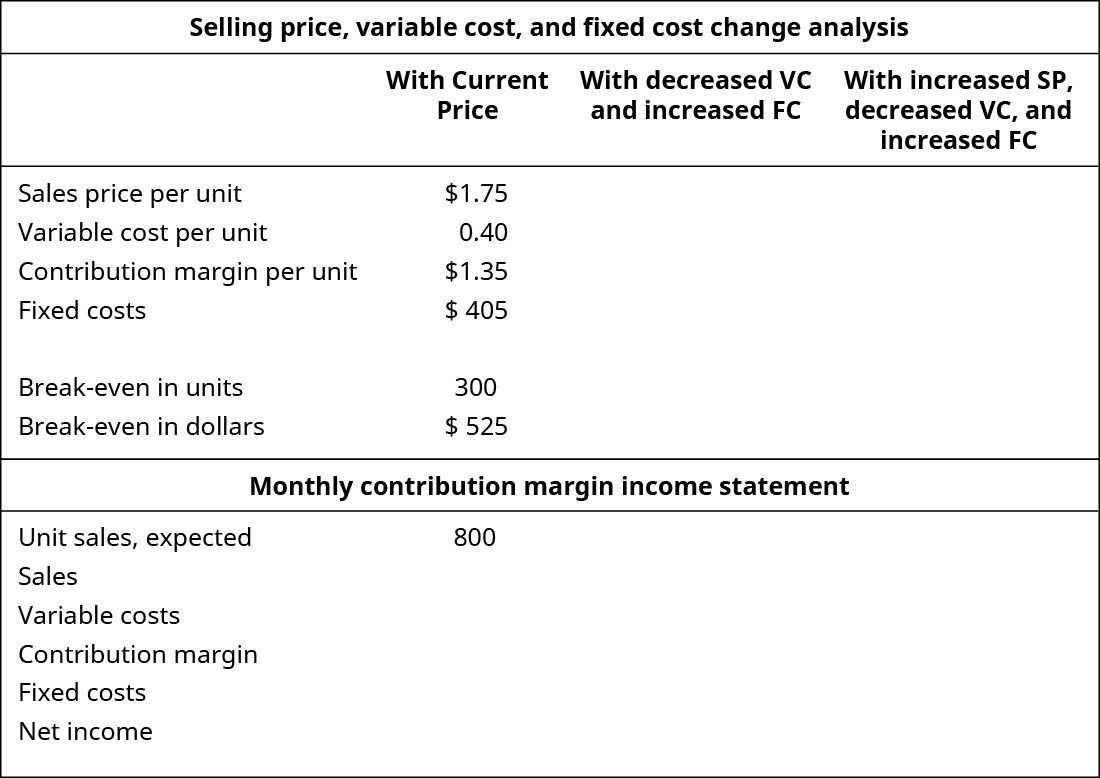
- Morris Industries manufactures and sells three products (AA, BB, and CC). The sales price and unit variable cost for the three products are as follows:

Their sales mix is reflected as a ratio of \(5:3:2\). Annual fixed costs shared by the three products are \(\$258,000\) per year.
- What are total variable costs for Morris with their current product mix?
- Calculate the number of units of each product that will need to be sold in order for Morris to break even.
- What is their break-even point in sales dollars?
- Using an income statement format, prove that this is the break-even point.
- Manatoah Manufacturing produces 3 models of window air conditioners: model 101, model 201, and model 301. The sales price and variable costs for these three models are as follows:

The current product mix is \(4:3:2\). The three models share total fixed costs of \(\$430,000\).
- Calculate the sales price per composite unit.
- What is the contribution margin per composite unit?
- Calculate Manatoah’s break-even point in both dollars and units.
- Using an income statement format, prove that this is the break-even point.
- Jakarta Company is a service firm with current service revenue of \(\$400,000\) and a \(40\%\) contribution margin. Its fixed costs are \(\$80,000\). Maldives Company has current sales of \(\$6,610,000\) and a \(45\%\) contribution margin. Its fixed costs are \(\$1,800,000\).
- What is the margin of safety for Jakarta and Maldives?
- Compare the margin of safety in dollars between the two companies. Which is stronger?
- Compare the margin of safety in percentage between the two companies. Now, which one is stronger?
- Compute the degree of operating leverage for both companies. Which company will benefit most from a \(15\%\) increase in sales? Explain why. Illustrate your findings in an Income Statement that is increased by \(15\%\).
Problem Set B
- A company sells mulch by the cubic yard. Grade A much sells for \(\$150\) per cubic yard and has variable costs of \(\$65\) per cubic yard. The company has fixed expenses of \(\$15,000\) per month. In August, the company sold \(240\) cubic yards of Grade A mulch.
- Calculate the contribution margin per unit for Grade A mulch.
- Calculate the contribution margin ratio of the Grade A mulch.
- Prepare a contribution margin income statement for the month of August.
- A company manufactures and sells blades that are used in riding lawnmowers. The \(18\)-inch blade sells for \(\$15\) and has per-unit variable costs of \(\$4\) associated with its production. The company has fixed expenses of \(\$85,000\) per month. In January, the company sold \(12,000\) of the \(18\)-inch blades.
- Calculate the contribution margin per unit for the \(18\)-inch blade.
- Calculate the contribution margin ratio of the \(18\)-inch blade.
- Prepare a contribution margin income statement for the month of January.
- Fill in the missing amounts for the four companies. Each case is independent of the others. Assume that only one product is being sold by each company.

- West Island distributes a single product. The company’s sales and expenses for the month of June are shown.

Using the information presented, answer these questions:
- What is the break-even point in units sold and dollar sales?
- What is the total contribution margin at the break-even point?
- If West Island wants to earn a profit of \(\$21,000\), how many units would they have to sell?
- Prepare a contribution margin income statement that reflects sales necessary to achieve the target profit.
- Wellington, Inc., reports the following contribution margin income statement for the month of May. The company has the opportunity to purchase new machinery that will reduce its variable cost per unit by \(\$10\) but will increase fixed costs by \(20\%\). Prepare a projected contribution margin income statement for Wellington, Inc., assuming it purchases the new equipment. Assume sales level remains unchanged.

- Karen’s Quilts is considering the purchase of a new Long-arm Quilt Machine that will cost \(\$17,500\) and will increase her fixed costs by \(\$119\). What would happen if she purchased the new quilt machine to realize the variable cost savings of \(\$5.00\) per quilt, and what would happen if she raised her price by just \(\$5.00\)? She feels confident that such a small price increase will not decrease the sales in units that will help her offset the increase in fixed costs. Given the following current prices how would the break-even in units and dollars change? Complete the monthly contribution margin income statement for each of these cases.
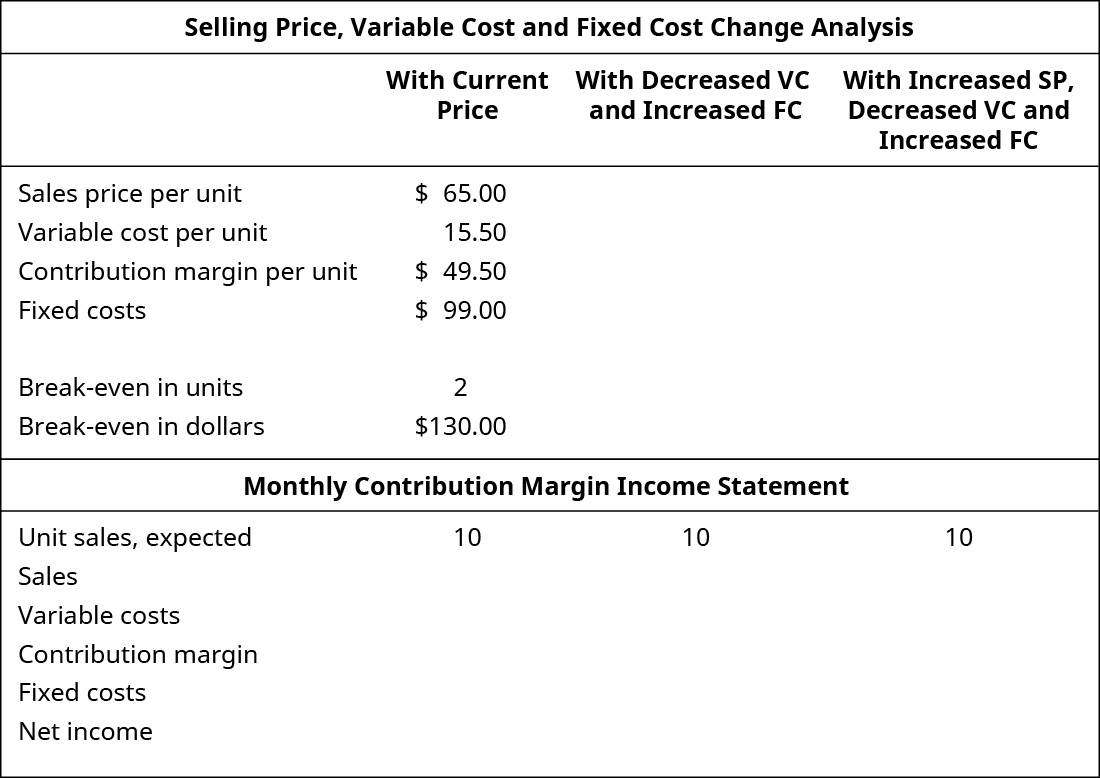
- Abilene Industries manufactures and sells three products (XX, YY, and ZZ). The sales price and unit variable cost for the three products are as follows:

Their sales mix is reflected as a ratio of \(4:2:1\). Annual fixed costs shared by the three products are \(\$345,000\) per year.
- What are total variable costs for Abilene with their current product mix?
- Calculate the number of units of each product that will need to be sold in order for Abilene to break even.
- What is their break-even point in sales dollars?
- Using an income statement format, prove that this is the break-even point.
- Tim-Buck-II rents jet skis at a beach resort. There are three models available to rent: Junior, Adult, and Expert. The rental price and variable costs for these three models are as follows:

The current product mix is \(5:4:1\). The three models share total fixed costs of \(\$114,750\).
- Calculate the sales price per composite unit.
- What is the contribution margin per composite unit?
- Calculate Tim-Buck-II’s break-even point in both dollars and units.
- Using an income statement format, prove that this is the break-even point.
- Fire Company is a service firm with current service revenue of \(\$900,000\) and a \(40\%\) contribution margin. Its fixed costs are \(\$200,000\). Ice Company has current sales of \(\$420,000\) and a \(30\%\) contribution margin. Its fixed costs are \(\$90,000\).
- What is the margin of safety for Fire and Ice?
- Compare the margin of safety in dollars between the two companies. Which is stronger?
- Compare the margin of safety in percentage between the two companies. Now which one is stronger?
- Compute the degree of operating leverage for both companies. Which company will benefit most from a \(10\%\) increase in sales? Explain why. Illustrate your findings in an Income Statement that is increased by \(10\%\).
Thought Provokers
- Mariana Manufacturing and Bellow Brothers compete in the same industry and in all respects their products are virtually identical. However, most of Mariana’s costs are fixed while Bellow’s costs are primarily variable. If sales increase for both companies, which will realize the greatest increase in profits? Why?
- Roald is the sales manager for a small regional manufacturing firm you own. You have asked him to put together a plan for expanding into nearby markets. You know that Roald’s previous job had him working closely with many of your competitors in this new market, and you believe he will be able to facilitate the company expansion. He is to prepare a presentation to you and your partners outlining his strategy for taking the company into this expanded market. The day before the presentation, Roald comes to you and explains that he will not be making a presentation on market expansion but instead wants to discuss several ways he believes the company can reduce both fixed and variable costs. Why would Roald want to focus on reducing costs rather than on expanding into a new market?
- As a manager, you have to choose between two options for new production equipment. Machine A will increase fixed costs by a substantial margin but will produce greater sales volume at the current price. Machine B will only slightly increase fixed costs but will produce considerable savings on variable cost per unit. No additional sales are anticipated if Machine B is selected. What are the relative merits of both machines, and how could you go about analyzing which machine is the better investment for the company in terms of both net operating income and break-even?
- Couture’s Creations is considering offering Joe, an hourly employee, the opportunity to become a salaried employee. Why is this a good idea for Couture’s Creations? Is this a good idea for Joe? What if Couture’s Creations entices Joe to agree to the change by offering him a salaried position with no risk of layoff during the winter lull? What if Joe agrees and Couture’s Creations lays him off anyway six months into the agreement?


